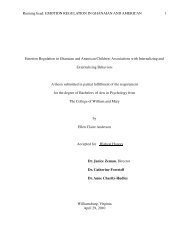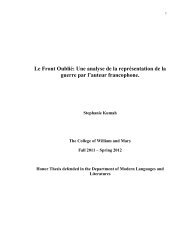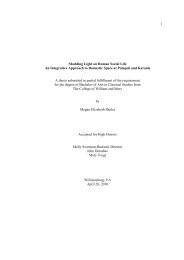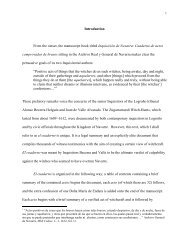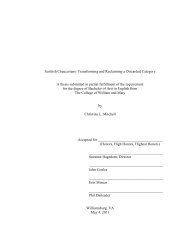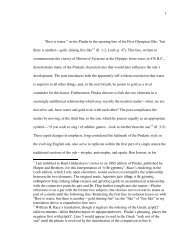Southern planter - The W&M Digital Archive
Southern planter - The W&M Digital Archive
Southern planter - The W&M Digital Archive
You also want an ePaper? Increase the reach of your titles
YUMPU automatically turns print PDFs into web optimized ePapers that Google loves.
1859.] THE SOUTHERN PLANTER. 391<br />
during the growing season, receives much<br />
more heat than the corresponding waters<br />
of the same latitude ; and, though the radiation<br />
at night is less from the water than<br />
the land, yet the accumulating increase of<br />
temperature of the latter will he much<br />
greater than that of the former. <strong>The</strong> reverse<br />
takes place in the winter. While,<br />
therefore, the mean temperature of the<br />
ocean and of the land, in the same latitude,<br />
may remain the same, the tendency of the<br />
land is to receive the greater portion of the<br />
heat of the whole year during the months<br />
of summer, and thus, by a harmonious arrangement<br />
with respect to the production<br />
of organic life, to increase the effect of the<br />
solar radiation, and to widen the limits<br />
within which plants of a peculiar character<br />
may be cultivated. Proximity to the sea,<br />
however, has another effect on the climate,<br />
which depends upon the currents of the<br />
former, by which the temperature of the<br />
earth, due to the latitude, is materially<br />
altered. Heated water is constantly carried,<br />
from the equatorial regions towards<br />
the poles, and streams of cold water returned,<br />
by means of which the temperature<br />
of the earth is modified, and the extremes<br />
reduced in intensity. * * *<br />
<strong>The</strong> effect of the prevailing currents of<br />
air, on the climate of different portions of<br />
the earth, is no less marked than proximity<br />
to the sea. * * * * *<br />
Professor Coffin, in his admirable paper<br />
on the winds of the northern hemisphere,<br />
has shown that, from the equator to the pole,<br />
the whole space is occupied by three great<br />
belts, or zones, of prevailing wind; the first<br />
extends from the equator to an average latitude<br />
of 35° north, in which the current is<br />
from the northeast, constantly growing less<br />
intense as we approach the northern limit;<br />
the second is that from 35° to about<br />
T)0°, the current from the west being more<br />
intense in the middle of the belt, and gradually<br />
diminishing, almost into a calm, on<br />
either side ; third, from 60° to the pole, or<br />
rather, to a point of greatest cold in the<br />
Arctic regions, the -wind is in a north-<br />
easterly direction.<br />
<strong>The</strong> first of these belts would constitute<br />
what is called the trade winds, produced by<br />
the combined effects of the heat of the sun,<br />
and the rotation of the earth ; the second,<br />
is the return trade, and the third, the cur-<br />
rent which would be produced by an oppo-<br />
site effect to that of the rarefaction of the<br />
:;<<br />
air by the sun at the equator, namely,<br />
the condensation of the air by the cold<br />
portion of the earth. <strong>The</strong> air should flow<br />
out, in every direction, from the coldest<br />
point, and, combining its motion towards<br />
the south with the rotation of the earth, it<br />
should take a direction from the cast to the<br />
west, or become a northeasterly wind.<br />
<strong>The</strong> effects which these currents must have<br />
upon the climate of the United States will be<br />
made clear by a little reflection. <strong>The</strong> trade<br />
winds within the tropics, charged with vapor,<br />
impinging upon the mountainous parts of<br />
South America, in their course towards the<br />
west, will deposit their moisture on the<br />
eastern slope, and produce a rainless district<br />
on the western side. Again, a lower portion<br />
of the Atlantic and Gulf trade wind<br />
will be deflected from these mountains along<br />
the eastern coast of the United States, and<br />
through the valley of the Mississippi, as a<br />
surface w r ind, and thus give rise to the moist<br />
and warm breezes from the south, of our<br />
summers, while the principal or upper por-<br />
tion of the trade wind, or the return wester-<br />
ly current, sweeping over the Pacific ocean,<br />
and consequently charged with moisture,<br />
will impinge on the coast range of moun-<br />
tains of Oregon and California, and, in ascending<br />
its sloped, deposit moisture on the<br />
western declivity, giving fertility and a<br />
healthful climate to a narrow strip of coun-<br />
try bordering on the ocean, and sterility to<br />
the eastern slope. All the moisture, however,<br />
will not be deposited in the passage<br />
over the first range, but a portion will be<br />
precipitated on the western side of the next,<br />
until it reaches the eastern elevated ridge<br />
of the Rocky mountain system, where, we<br />
think, it will be nearly, if not quite, ex-<br />
hausted. East of this ridge, and, as it were,<br />
in its shadow, there will exist a sterile belt,<br />
extending in a northerly and southerly direction<br />
many hundred miles. <strong>The</strong> whole<br />
country, also, included between the eastern<br />
ridge of the Rocky mountains and the Pa-<br />
cific Ocean, with the exception of the narrow<br />
strip before mentioned, will be deficient<br />
in moisture, and on account of the heat,<br />
evolved, as before shown, by the condensation<br />
of moisture on the ridges, will be at a<br />
much higher temperature than that due to<br />
latitude. This mountain region, and the<br />
sterile belt east of it, occupy an area about<br />
equal to one third of the whole surface of<br />
the United States, which, with our present<br />
knowledge of the laws of nature, and their




